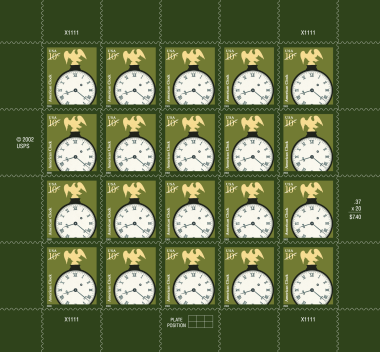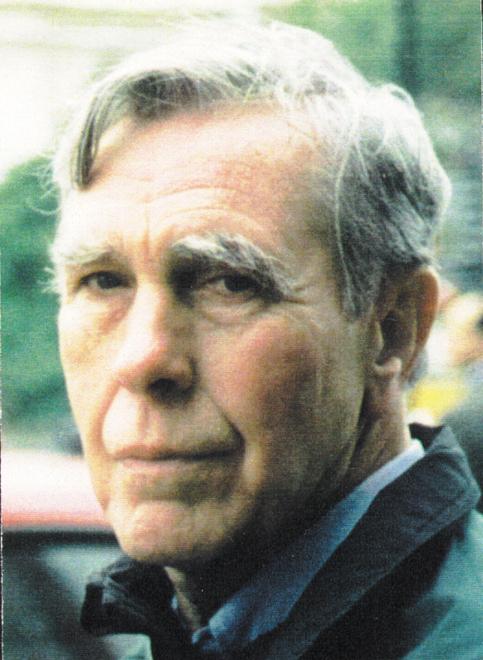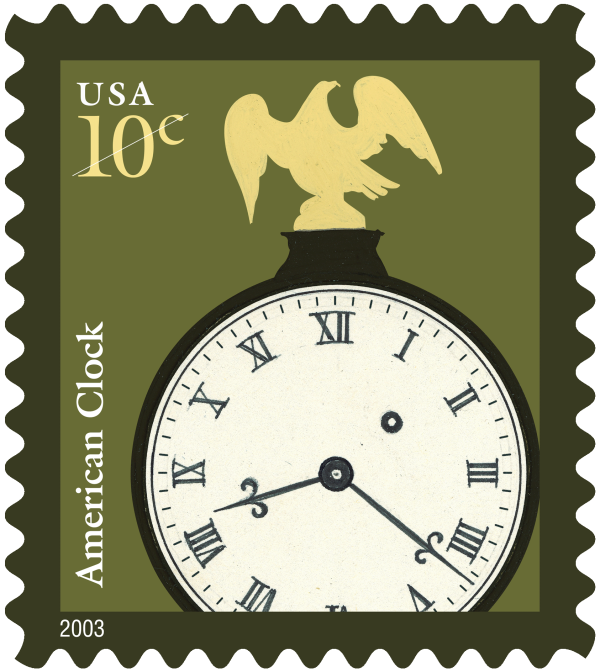
About This Stamp
The self-adhesive American Clock stamp is the second issue of the American Design Series that began with the 2002 American Toleware coil stamp. It replaced the 10¢ Red Cloud stamps of 1987-94. The design is from a clock made about 1805 by Simon Willard of Massachusetts.
Using simple hand tools, the early American clockmakers created masterpieces that kept time with precision. After crafting the mechanism, clockmakers frequently commissioned cabinetmakers to make cases to conceal the pendulum and weights. The result was a functional yet beautiful piece of furniture.
Simon Willard (1753-1848) was a noteworthy American clockmaker. He established a workshop in 1780, was given complete responsibility for the clocks at Harvard University, and contributed elegant timepieces for the U.S. Senate and Supreme Court.
Willard developed a compact wall timepiece known as the “banjo clock.” Unlike other clocks, the design omits the striking mechanism and indicates time only by its hands and dial. Although Willard was granted a patent for his invention in 1802, many others imitated his design.
Banjo clocks feature a round opening with a painted dial. A long-waisted wooden case and a rectangular box with a hinged door, each with decorative glass panels, surround the pendulum. A cast iron eagle (finial) tops most banjo clocks. Only 4,000 authentic Willard banjo clocks are known.
Stamp Art Director

Derry Noyes
For more than 40 years Derry Noyes has designed and provided art direction for close to 800 United States postage stamps and stamp products. She holds a bachelor of arts degree from Hampshire College and a master of fine arts degree from Yale University.
Noyes worked as a graphics designer at Beveridge and Associates, a Washington, D.C., firm, until 1979 when she established her own design firm, Derry Noyes Graphics. Her clients have included museums, corporations, foundations, and architectural and educational institutions. Her work has been honored by American Illustration, the Art Directors Club of Metropolitan Washington, Communication Arts, Critique magazine, Graphis, Creativity International, and the Society of Illustrators.
Before becoming an art director for the U.S. Postal Service, she served as a member of the Citizens' Stamp Advisory Committee from 1981 to 1983.
Noyes is a resident of Washington, D.C.
Stamp Artist

Lou Nolan
Longtime stamp artist Lou Nolan studied fine art at the Corcoran School of Art in Washington, DC, his hometown, and graduated from New York's Parsons School of Design in 1952. After working as a book designer and illustrator in New York, he returned to Washington to begin a freelance career. Following a ten-year partnership at a graphic design firm, Nolan returned to freelancing. By the time he retired in 1995, he had created designs for NASA, the Smithsonian Institution, each branch of the U.S. Armed Forces, and many federal agencies. His work was honored by the Art Directors Club of New York and Print magazine. He won gold and silver medals from the Art Directors Club of Metropolitan Washington.
Nolan designed many stamp products for the U.S. Postal Service® and more than a dozen stamps, including the first five in the American Design series that began in 2002. Some of these stamps have been reprinted in recent years including the Chippendale Chair (2007, 2014), the American Clock (2008), and the Tiffany Lamp (2007, 2009).
Mr. Nolan died on October 24, 2008.
